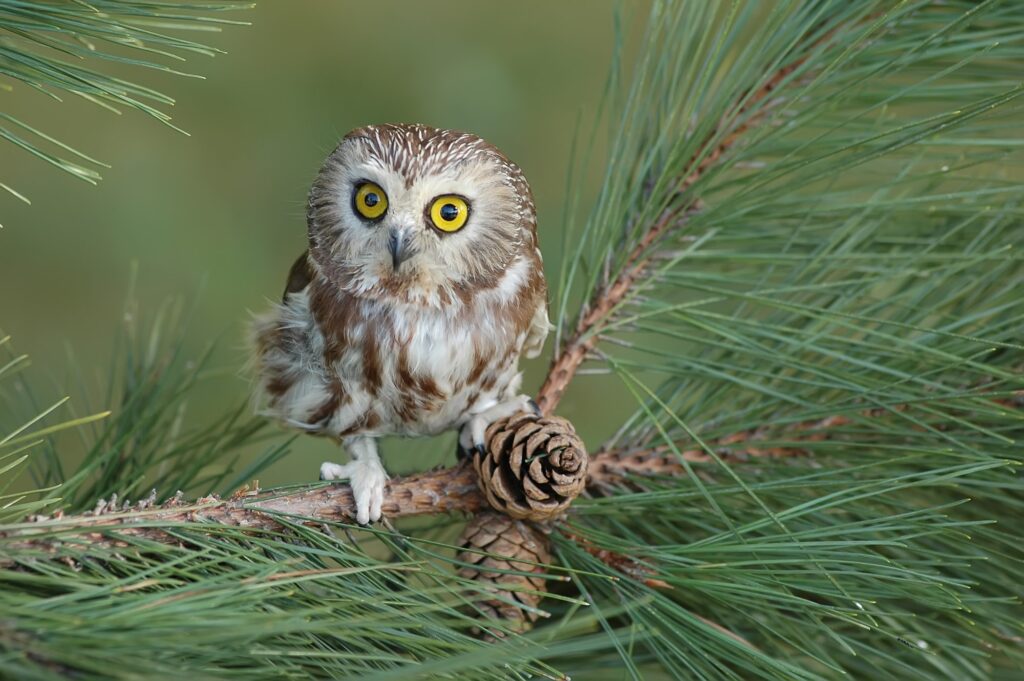It’s no wonder eight species of owls find Kansas a suitable habitat for both breeding and everyday life — the state is home to the breathtaking Cheyenne bottoms, Gypsum Hills, and Quivira, and it accommodates several mixed-grass prairies, wetlands, hayfields, scrublands, and pastures.
Kansas is also flooding with a wide range of food and prey items in the form of kangaroo rats, mice, and voles for these bird species to eat!
Despite the lack of national parks in the Sunflower State, it hosts 5.2 million acres of forests and woodlands, which is why so many bird species (including the owls we’re talking about today) call it home. Stay tuned as we take a closer look at these eight majestic birds!
Great Horned Owl
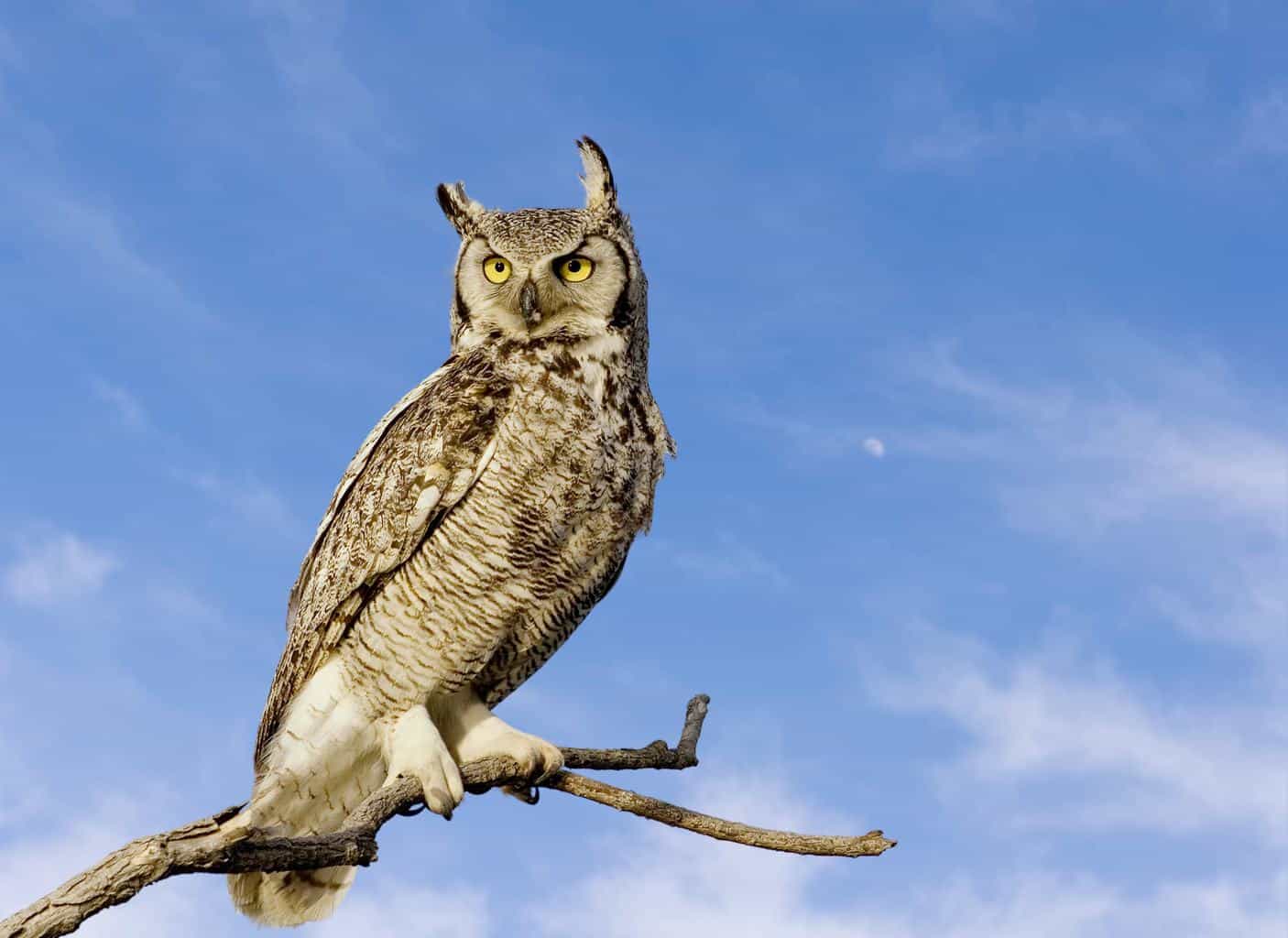
- Scientific Name: Bubo virginianus
- Length: 18.1-26 inches
- Weight: 50 ounces
- Wingspan: 55.2 inches
The great horned owl is the most widely recognized species of these birds in the northern United States, and these raptors are year-round birds in Kansas. Throughout the nesting season, they stay around places with breeding sites in forests and trees rather than open prairie and grasslands.
Great horned owls mainly feed on rabbits and rodents, but they may also prey on larger animals, sometimes up to two times their size!
Nesting season for this species of birds starts as early as January, and during this time, males call out for females, normally from dusk and midnight. The owls will stay in abandoned and uninhabited stick homes made by hawks, crows, and squirrels until the season ends.
Your highest chance of catching a glimpse of this bird is looking in tall trees close to streams and extensive greeneries, like parks or golf courses. The owl is easily recognized by its big size and the standing tufts of feathers on their heads. Keep your ears open on evening walks, and you may hear pairs of females and males calling one another.
Eastern Screech-Owl
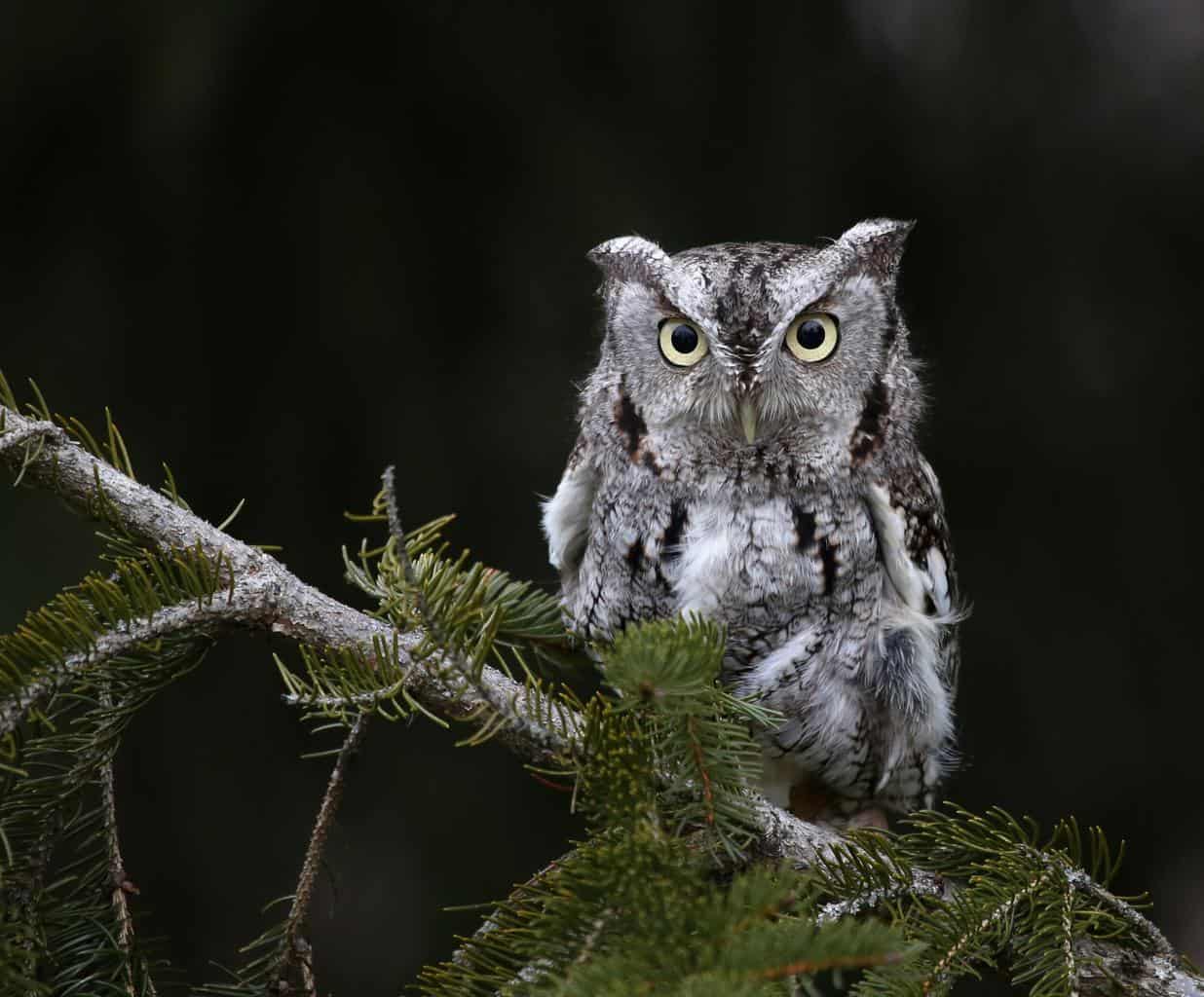
- Scientific Name: Megascops asio
- Length: 6-10 inches
- Weight: 5.6 ounces
- Wingspan: 19-24 inches
Eastern screech-owls mostly live on the west edge of Kansas, and these minuscule birds stay in their habitats all year-round. They nest in wooded areas, specifically in small spaces, such as hallowed tree burrows.
Often, the eastern screech-owl isn’t seen because it’s hushed and not as loud as great horned or barn owls. Additionally, it stays hidden and doesn’t make its presence known, so you’ll have to put in some effort to find it. You’ll know these owls by their grey or red bodies.
The screech-owls’ vision and hearing senses are incredible, straining their ears to hear even the quietest sounds their prey may make. This owl’s favorite foods include insects, small rodents, and occasionally, a rat.
Barred Owl
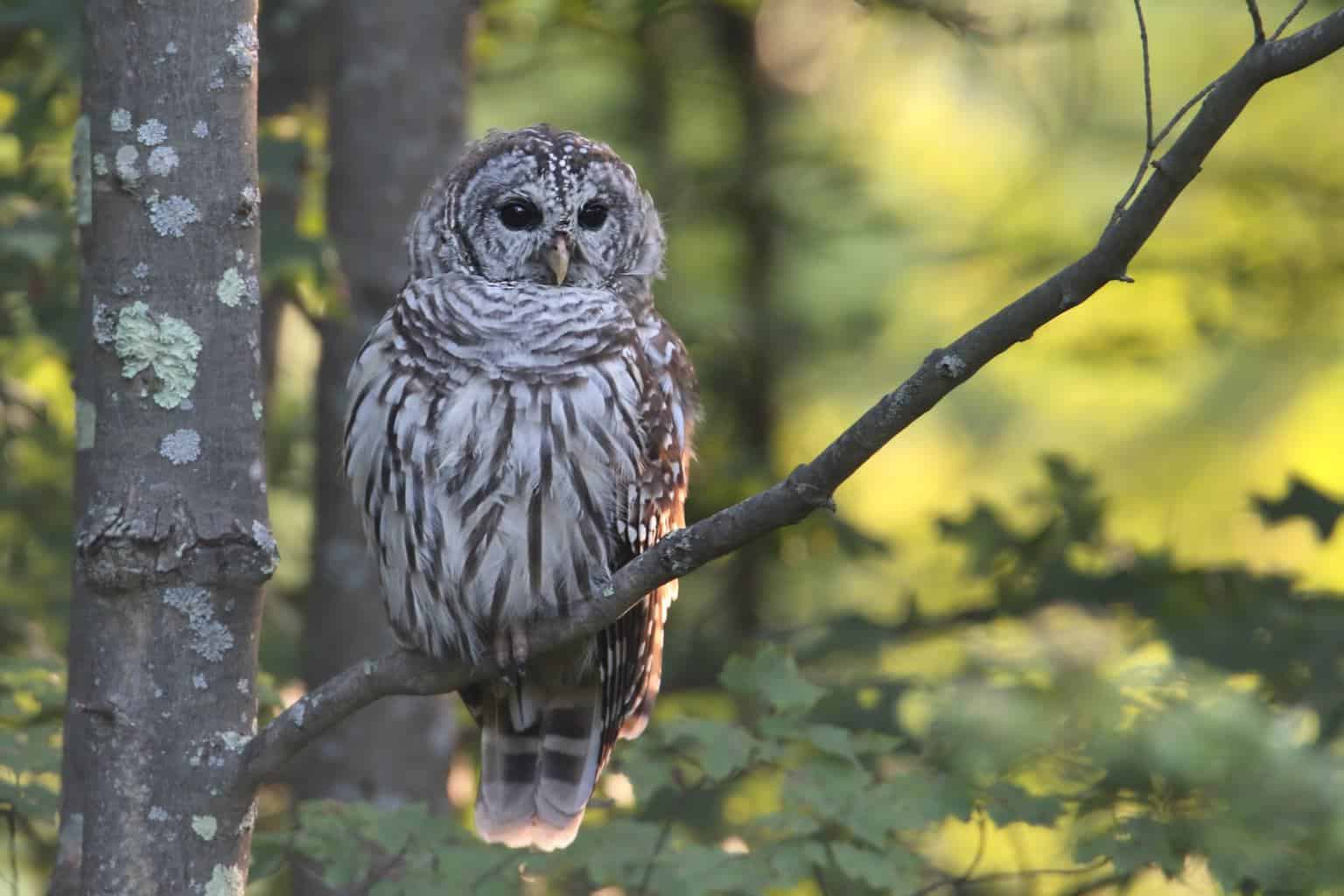
- Scientific Name: Strix varia
- Length: 16-25 inches
- Weight: 26 ounces
- Wingspan: 38-49 inches
Barred owls are pretty common, but they’re hard to catch a glimpse of, as they blend in perfectly with the trees around them. If you have woods on your property, there may be a barred owl there, and you don’t even know it!
This species prefers to nest in densely wooded areas, and because of this, you’ll likely find them in the east region of Kansas. You’ll hear them hooting the most in May and April. If you want to recognize their call, strain your ears for a distinctive call that sounds like it’s asking, “Who cooks for you?”
Like many owls, barred owls have humongous eyes. However, they have brown irises instead of the typical yellow found on screech-owls or great horned owls. Their brown eyes give them a wide-eyed, soft appearance that makes them look calm.
Barred owls have pretty sensitive ears that allow them to triangulate sounds. This helps them pinpoint any slight sound that human ears wouldn’t be able to pick up.
Northern Saw-Whet Owl

- Scientific Name: Aegolius acadicus
- Length: 6.5-9 inches
- Weight: 1.9-5.3 ounces
- Wingspan: 16.5-22.2 inches
Northern saw-whet owls’ preferred habitat is forest areas, but sometimes, they like to live in vast, open areas. During their non-breeding season, Kansas is part of their range, and they stay in the state for months.
These birds have incredibly soft feathers to help them fly silently, and additionally, their talons are sharper than average. If you look closely at them, you’ll see bumpy pads on the bottoms of their feet. Those pads help keep their food stuck in their grasp so they can fly away with it.
When you see a saw-whet owl, be careful! Don’t be fooled by its charm and friendly appearance; these little raptors can be feisty and aggressive, despite their small size.
Barn Owl
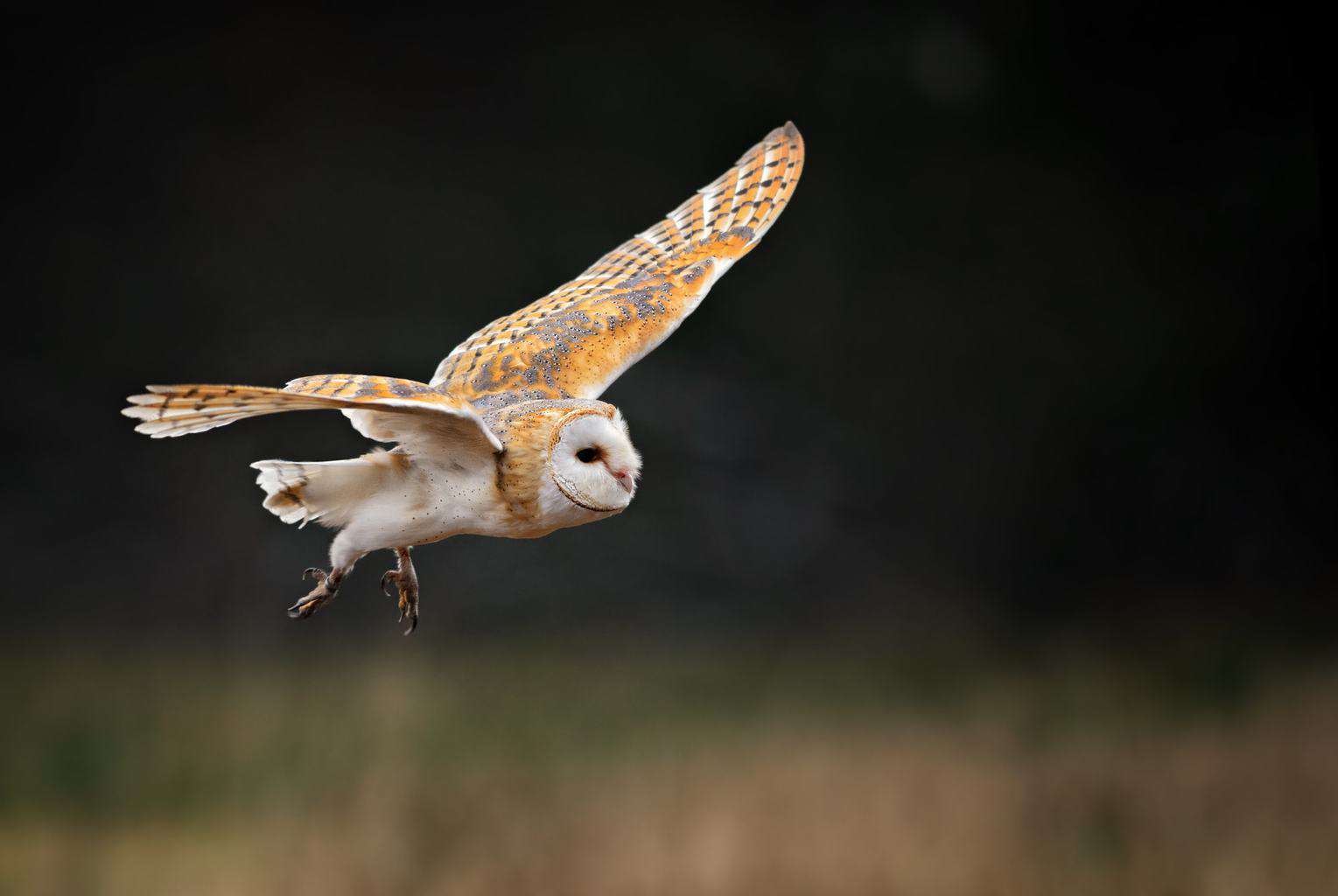
- Scientific Name: Tyto alba
- Length: 12.6-15.8 inches
- Weight: 14.1-24.7 ounces
- Wingspan: 39.4-49.2 inches
The barn owl is the most widely distributed and common owl species in the world. The bird is commonly found along the Cimarron River in the southwestern part of the state, particularly Morton County.
As the weather gets colder, juvenile barn owls migrate to the south, and the remaining owls will stay in Kansas throughout the winter. So, you’ll only catch mature owls at that time of the year.
Barn owls rely on their hearing more than their eyesight as they hunt. They have an impeccable sense of hearing that allows them to hear a mouse’s heartbeat, even if it’s four inches below the ground! They strain their ears to locate their prey, and they almost always succeed in getting what they want to eat.
Short-Eared Owl

- Scientific Name: Asio flammeus
- Length: 13-17 inches
- Weight: 7.3-16.8 ounces
- Wingspan: 33-43 inches
Unlike most owls, the short-eared species of owls are often active during the daytime. On top of that, they occasionally fly long and high ranges up to 100 feet, which is an uncommon characteristic for owls.
Sometimes, short-eared owls will spend their winters in Kansas, but during the breeding season, they migrate north, stretching into Canada.
The main prey of the short-eared owl is voles, but the bird will also eat other small mammals, birds, and some reptiles. In the instance of a food shortage, short-eared owls will move their nests to areas with available food. Their adaptive nature helps them get used to the new place in a short time.
These owls have buffy or white feathers on their underbellies, and they have unique stripes on their upper breasts and throats. While in flight, their bodies look two-toned: paler on the belly and breast but black on the throat.
Burrowing Owl

- Scientific Name: Athene cunicularia
- Length: 7.5-9.8 inches
- Weight: 5.3 ounces
- Wingspan: 21.6 inches
The burrowing owl likes to settle in pastures and prairies, and, as obvious from the species’ name, they’re often seen using burrows of ground squirrels for their nests.
During their breeding season, you’ll see these owls throughout all regions of Kansas. Their range usually extends into the western border of the state. Their habitat is, unfortunately, gradually becoming smaller because there aren’t many available burrows. However, they use abandoned holes to nest inside instead.
These owls have yellow eyes, white eyebrows, and small but visible tufts of feathers that look like ears. They also have long legs, short tails, and rounded heads.
Their diet varies with location and season. In the summertime, they eat large insects like grasshoppers and crickets. For the rest of the year, though, they feed on mammals like ground squirrels, mice, voles, and some little birds.
Long-Eared Owl

- Scientific Name: Asio otus
- Length: 13.7-15.7 inches
- Weight: 8.81 ounces
- Wingspan: 35.4-40 inches
The long-eared owl is only present in Kansas outside of its breeding season, and during these times, you can see the bird in all regions of the state. Most sightings of the owl are in the eastern half of the state, and the sightings increase during the wintertime.
Long-eared owls are known for their superb camouflage and secretive nature. Just like many owls, they hunt mostly at night, sometimes before sunset; that’s when they feed their young.
This species of owls forages over open woods or in fields, flying a few feet above the ground. They try to catch their prey while flying before diving down to catch it.
Male long-eared owls let out a low “hoo-hooo-hoooo,” repeated 10 to 200 times with each note lasting two to three seconds. The female has a rough, raspy buzz call, and it frequently duets with the male. These owls often call out during nighttime hours. When frightened, long-eared owls let out a “wheek-wheek” or yell like a cat.
These birds mainly feed on small mammals and heavy rodents, and in Kansas, their diet consists of voles, deer mice, and kangaroo rodents.
Final Thoughts
Kansas is undoubtedly a great place for owls to live peacefully, and the state provides all they need with its beautiful woodland areas, trees, and nesting sites.
Keep your eyes peeled and your ears open while you’re on an evening walk, and you may hear owls calling out for one another. They might even drop by your porch looking for something to eat!
Interested to know more about the wide variety of birds in the state? Check out the 9 hawks that live in Kansas; any avid birdwatcher would be impressed!

